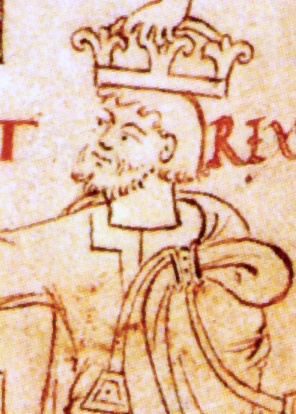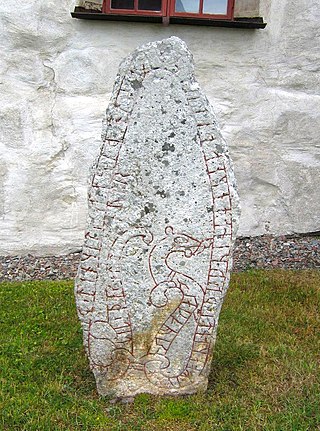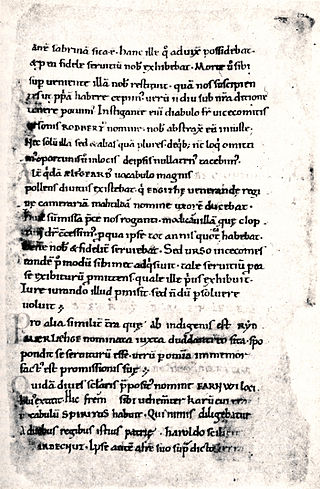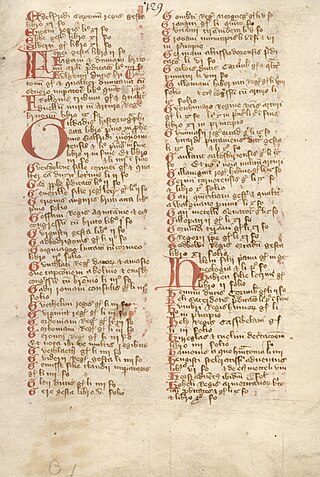External links
- Vikingatidens ABC in Historiska Världer – in Swedish
Clemens Church (S:t Stefans kyrka) is a church that was rediscovered after archaeological surveys in Lund.
The church was of a type with standing palisade wall (tiles) on a base log (väggplankor på syll).
The Encomium Emmae Reginae suggests that, in an effort to spread Christianity throughout Scandinavia, the Danish King Sweyn Forkbeard constructed a Monastery in Lund and dedicated it to the holy trinity. The author of the Encomium Emmae Reginae, a Flemish monk, was likely unaware that no monasteries had as of yet been constructed in Scandinavia by the time of King Sweyn Forkbeard's death (3 February 1014). Thus, the Clemens Church of Lund could very well have been the “monastery” constructed on the orders of King Sweyn Forkbeard. If so, the Clemens Church at Lund serves as an important landmark from the Christianization of Scandinavia.

Emma of Normandy was a Norman-born noblewoman who became the English, Danish, and Norwegian queen through her marriages to the Anglo-Saxon king Æthelred the Unready and the Danish king Cnut the Great. A daughter of the Norman ruler Richard the Fearless and Gunnor, she was Queen of the English during her marriage to King Æthelred from 1002 to 1016, except during a brief interruption in 1013–14 when the Danish king Sweyn Forkbeard occupied the English throne. Æthelred died in 1016, and Emma married Sweyn's son Cnut. As Cnut's wife, she was Queen of England from their marriage in 1017, Queen of Denmark from 1018, and Queen of Norway from 1028 until Cnut died in 1035.

Sweyn Forkbeard was King of Denmark from 986 until his death, King of England for five weeks from December 1013 until his death, and King of Norway from 999/1000 until 1013/14. He was the father of King Harald II of Denmark, King Cnut the Great, and Queen Estrid Svendsdatter.

Cnut, also known as Canute and with the epithet the Great, was King of England from 1016, King of Denmark from 1018, and King of Norway from 1028 until his death in 1035. The three kingdoms united under Cnut's rule are referred to together as the North Sea Empire by historians.

Harald "Bluetooth" Gormsson was a king of Denmark and Norway.

Edmund Ironside was King of the English from 23 April to 30 November 1016. He was the son of King Æthelred the Unready and his first wife, Ælfgifu of York. Edmund's reign was marred by a war he had inherited from his father; his cognomen "Ironside" was given to him "because of his valour" in resisting the Danish invasion led by Cnut.
Ælfgifu of Northampton was the first wife of Cnut the Great, King of England and Denmark, and mother of Harold Harefoot, King of England. She was regent of Norway from 1030 to 1035.

Encomium is a Latin word deriving from the Ancient Greek enkomion (ἐγκώμιον), meaning "the praise of a person or thing." Another Latin equivalent is laudatio, a speech in praise of someone or something.

Thorkell the Tall, also known as Thorkell the High in the Anglo-Saxon Chronicle, was a prominent member of the Jomsviking order and a notable lord. He was a son of the Scanian chieftain Strut-Harald, and a brother of Jarl Sigvaldi, Hemingr and Tófa. Thorkell was the chief commander of the Jomsvikings and the legendary stronghold Jomsborg, on the Island of Wollin. He is also credited as having received the young Cnut the Great into his care and taken Cnut on raids. The Encomium Emmae, a document aimed at the movers and shakers of the Anglo-Scandinavian court in the early 1040s, describes Thorkell as a great war leader and warrior.

Eadric Streona was Ealdorman of Mercia from 1007 until he was killed by King Cnut. Eadric was given the epithet "Streona" in Hemming's Cartulary because he appropriated church land and funds for himself. Eadric became infamous in the Middle Ages because of his traitorous actions during the Danish re-conquest of England.
Erik Hakonsson, also known as Eric of Hlathir or Eric of Norway, was Earl of Lade, Governor of Norway and Earl of Northumbria. He was the son of Earl Hákon Sigurðarson and brother of the legendary Aud Haakonsdottir of Lade. He participated in the Battle of Hjörungavágr, the Battle of Svolder and the conquest of England by King Canute the Great.

Harald Svendsen was King of Denmark from 1014 until his death in c. 1018. He was the youngest son of Sweyn Forkbeard and Gunhild of Wenden, and was regent while his father was fighting Æthelred the Unready in England. He inherited the Danish throne in 1014, and held it while his brother, the later king Cnut the Great conquered England. After his death in 1018(?), he was succeeded by Cnut the Great. Little detail is known about Harald II.

Encomium Emmae Reginae or Gesta Cnutonis Regis is an 11th-century Latin encomium in honour of the English queen Emma of Normandy. It was written in 1041 or 1042, probably by a monk of Saint-Omer, Normandy.

The Christianization of Scandinavia, as well as other Nordic countries and the Baltic countries, took place between the 8th and the 12th centuries. The realms of Denmark, Norway and Sweden established their own archdioceses, responsible directly to the pope, in 1104, 1154 and 1164, respectively. The conversion to Christianity of the Scandinavian people required more time, since it took additional efforts to establish a network of churches.
Events from the 1040s in England.

All Saints Abbey (Allhelgonaklostret) was a Benedictine monastery at Lund in Scania, Sweden. Located in what was once part of Denmark, it was one of earliest Danish religious houses. There are no remnants of the abbey remaining today.

Viking activity in the British Isles occurred during the Early Middle Ages, the 8th to the 11th centuries CE, when Scandinavians travelled to the British Isles to raid, conquer, settle and trade. They are generally referred to as Vikings, but some scholars debate whether the term Viking represented all Scandinavian settlers or just those who used violence.

The Danish House of Knýtlinga was a ruling royal house in Middle Age Scandinavia and England. Its most famous king was Cnut the Great, who gave his name to this dynasty. Other notable members were Cnut's father Sweyn Forkbeard, grandfather Harald Bluetooth, and sons Harthacnut, Harold Harefoot, and Svein Knutsson. It has also been called the House of Canute, the House of Denmark, the House of Gorm, or the Jelling dynasty.

The story of King Canute and the tide is an apocryphal anecdote illustrating the piety or humility of King Canute the Great, recorded in the 12th century by Henry of Huntingdon.

The Courtenay Compendium is a medieval English manuscript containing a miscellany of historical texts. It contains three blocks of texts. The first concerns British and English history. The second has an oriental focus and contains accounts of Europeans in China, the Crusades, Islam and the rise of the Mongols. The third contains prophecies.

De Machometo is a brief anonymous Latin tract on the life of Muḥammad from a Christian point of view. It begins in the reign of Pope Boniface IV (608–615). Its account is cobbled together from a variety of sources, including the fifth dialogue of Petrus Alphonsi's Dialogi in quibus impiae Judaeorum confutantur, the Corozan legend and possibly the Libellus in partibus transmarinis de Machometi fallaciis from Vincent of Beauvais's Speculum historiale. The composite account is very similar to the account of Muḥammad found in the Golden Legend.